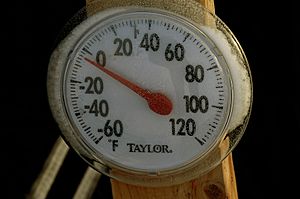Negative number facts for kids
A negative number is a number that shows an opposite direction or value. Think of it like this: if going up is positive, then going down is negative. If earning money is positive, then spending money is negative.
For example, if you are 10 feet above sea level, that's a positive 10. But if you are 10 feet below sea level, that's a negative 10. If you add 5 minutes to a timer, that's positive 5. If you go back 5 minutes in time, that's negative 5.
Numbers like 1, 2, 3, and so on are called positive numbers. When we put positive numbers, negative numbers, and the number zero all together, they are called integers.
The number zero is special. It is neither positive nor negative. Zero is its own opposite. This means +0 is the same as −0.
A negative number is always smaller than zero.
You write a negative number by putting a minus sign ("−") in front of a positive number. For instance, 3 is a positive number, but −3 is a negative number. You can read it as "negative three" or "minus three." It means the opposite of 3.
Contents
Negative Numbers on a Number Line
Negative numbers are found to the left of zero on a number line. A number and its opposite are always the same distance from zero. For example, the negative number −3 is just as far to the left of zero as the positive number 3 is to the right of zero.
Sometimes, to make it clear, we write a pair of opposite numbers as −3 and +3.
When you add a number and its opposite, the answer is always zero. So, the sum of −3 and +3 is 0. We can write this as −3 + 3 = 0 or 3 + (−3) = 0. We often say that a number and its opposite "cancel each other out."
Doing Math with Negative Numbers
Working with negative numbers in math can be a bit tricky at first, but it follows clear rules.
Adding Negative Numbers
Adding a negative number is like subtracting a positive number.
- For example, if you have 9 and you add negative 1:
9 + (−1) = 9 − 1 = 8 Imagine you have 9 cookies, and you "add" a debt of 1 cookie. You end up with 8 cookies.
Subtracting Negative Numbers
Subtracting a negative number is the same as adding a positive number.
- For example, if you have 6 and you subtract negative 8:
6 − (−8) = 6 + 8 = 14 Think of it as removing a debt. If you remove a debt of 8 dollars, it's like someone gave you 8 dollars.
Multiplying Negative Numbers
When you multiply negative numbers, the rules for the sign are important:
- A negative number multiplied by another negative number gives you a positive number.
(−3) × (−2) = 3 × 2 = 6 It's like saying the "opposite of the opposite" is positive.
- A negative number multiplied by a positive number gives you a negative number.
(−4) × 5 = −(4 × 5) = −20 Here, you multiply the numbers as usual, but the answer will be negative.
Where We Use Negative Numbers
Negative numbers are used in many real-life situations:
- Temperature: When it's very cold, temperatures can drop below zero, like −5°C.
- Money: If a person or company owes money, they might have a negative amount in their bank account, meaning they are in debt.
- Science: Scientists use negative numbers in many areas, such as measuring electrical charges or depths below sea level.
- Sports: In some sports, like golf, scores can be negative if you are under par.
- Elevators: Some buildings have floors below the ground level, which are often labeled with negative numbers (like B1 for basement 1, or -1).
Images for kids
See also
 In Spanish: Número negativo para niños
In Spanish: Número negativo para niños



